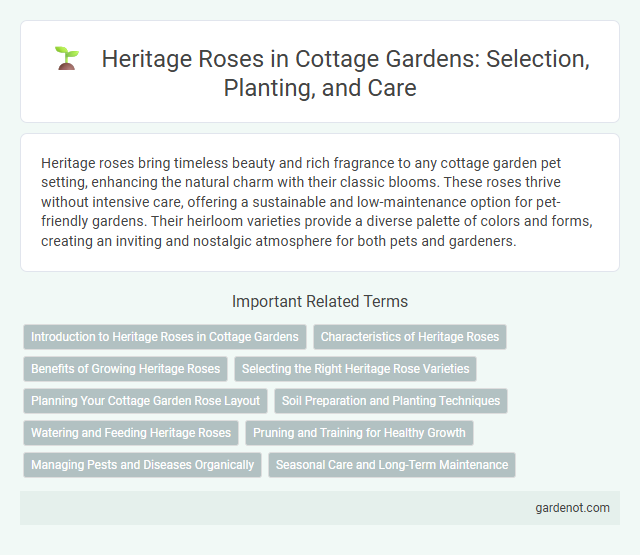Heritage roses bring timeless beauty and rich fragrance to any cottage garden pet setting, enhancing the natural charm with their classic blooms. These roses thrive without intensive care, offering a sustainable and low-maintenance option for pet-friendly gardens. Their heirloom varieties provide a diverse palette of colors and forms, creating an inviting and nostalgic atmosphere for both pets and gardeners.
Introduction to Heritage Roses in Cottage Gardens
Heritage roses, also known as old garden roses, are prized in cottage gardens for their rich fragrance, diverse colors, and historical significance dating back centuries. These roses thrive in informal settings, blending seamlessly with wildflowers and perennial borders, creating a timeless, romantic ambiance. Their disease resistance and low maintenance requirements make them ideal for sustainable cottage garden designs.
Characteristics of Heritage Roses
Heritage roses are prized for their robust fragrance and intricate bloom structures that evoke classic garden aesthetics. These roses typically exhibit strong disease resistance and adaptability to diverse climates, making them ideal for sustainable cottage garden environments. Their rich color palette and repeat flowering habit enhance garden vibrancy throughout the growing season.
Benefits of Growing Heritage Roses
Heritage roses offer unmatched fragrance and rich color diversity, enhancing the aesthetic appeal of any cottage garden. Their natural disease resistance reduces the need for chemical treatments, promoting eco-friendly gardening practices. These roses also provide valuable habitat and food sources for pollinators, contributing to local biodiversity and garden health.
Selecting the Right Heritage Rose Varieties
Selecting the right heritage rose varieties for a cottage garden involves considering bloom size, fragrance, and growth habit to complement the informal, romantic style. Popular choices include Rosa gallica for its rich colors and historical significance, Rosa damascena known for its strong scent and repeat flowering, and Rosa alba valued for its disease resistance and graceful blooms. Prioritize varieties that thrive in your local climate and soil conditions to ensure robust growth and long-lasting beauty.
Planning Your Cottage Garden Rose Layout
When planning your cottage garden rose layout, prioritize heritage rose varieties for their disease resistance and rich fragrance. Position taller varieties like Rosa gallica at the back of beds to create vertical interest while planting lower-growing species near pathways to enhance accessibility and visual charm. Incorporate companion plants such as lavender and foxglove to improve soil health and promote a natural, harmonious garden ecosystem.
Soil Preparation and Planting Techniques
Heritage roses thrive in well-drained, loamy soil enriched with organic matter such as compost or aged manure to ensure optimal root development. Planting should be done in early spring or fall, placing the graft union just below soil level to protect against frost and encourage strong growth. Proper spacing of at least 3 feet between plants promotes air circulation, reducing disease risk and supporting vigorous blooming.
Watering and Feeding Heritage Roses
Heritage roses thrive with consistent deep watering, especially during dry spells, ensuring the soil remains moist but not waterlogged to prevent root rot. Feeding with a balanced, slow-release fertilizer rich in potassium and phosphorus promotes vibrant blooms and strong root development throughout the growing season. Applying organic mulch around the base retains moisture, regulates soil temperature, and improves soil fertility for optimal heritage rose health.
Pruning and Training for Healthy Growth
Heritage roses thrive with careful pruning and training, which promotes healthy growth and abundant blooms. Prune annually in late winter to remove dead or weak stems, shaping the plant to enhance air circulation and sunlight exposure. Training involves gently tying flexible canes to supports, encouraging a balanced structure and preventing disease.
Managing Pests and Diseases Organically
Heritage roses in cottage gardens thrive with organic pest management techniques such as introducing beneficial insects like ladybugs and lacewings that naturally reduce aphid populations. Neem oil and insecticidal soaps provide effective, non-toxic control against common rose pests like spider mites and thrips without harming pollinators. Regular pruning and proper air circulation help prevent fungal diseases such as black spot and powdery mildew, maintaining the health and beauty of heritage rose bushes.
Seasonal Care and Long-Term Maintenance
Heritage roses require careful seasonal care, including early spring pruning to encourage vigorous growth and the removal of dead or diseased wood to prevent fungal infections. Regular feeding with balanced, organic fertilizers throughout the growing season supports robust blooms and healthy foliage. Long-term maintenance involves evaluating plant health annually, ensuring proper air circulation by spacing plants adequately, and mulching to retain soil moisture and suppress weeds.
Heritage rose Infographic

 gardenot.com
gardenot.com